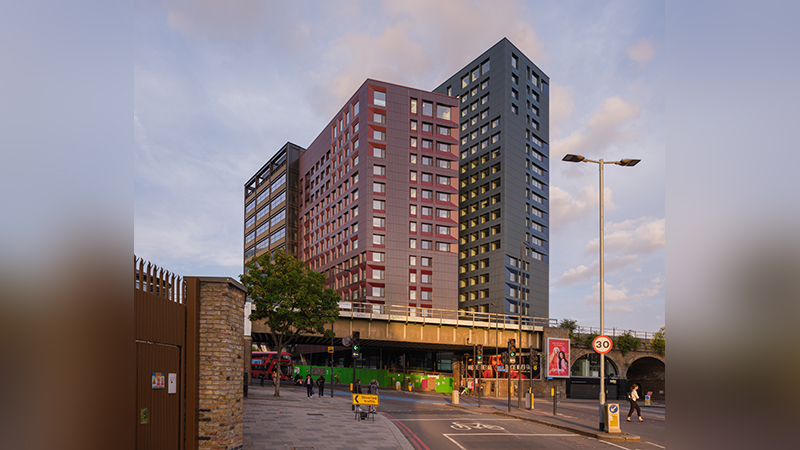UK cities now must compete on the global stage, and the challenge for our cities in a post-industrial landscape is to develop their own individual brand and, if possible, a unique selling point which will attract inward investment and talent, both nationally and internationally. This can be done in various ways and there are numerous applicable factors, not least global and local economies, but it is important that a city first understands its demographics, resources and history – this is what gives a city its personality.
The future is modular
Following the Ministry of Housing, Communities and Local Government’s pledge to deliver 300,000 new homes per year through new build innovation, the private sector is now fully engaged, and a number of major players in the industry have now taken the leap into the world of modular, attracted by the benefits of shortening build periods, reducing risk of on-site accidents, cutting delays and creating less waste. The recent construction of a hospital in 10 days in China shows how modular can help to alleviate emergency situations too.
We have moved a long way since the “pre-fabs” era, with modular construction methods now being used for all types of buildings. The tallest modular building in Europe is Apex House in Wembley – 29 stories of self-supporting modules, completed within 12 months. Urban Splash has launched its “House” brand, which allows customers to design their new house according to their own needs – lounge upstairs or downstairs? Sweden leads the way in Europe with 84% of its new housing being pre-fabricated, whereas the UK is only at 7.5%. So, while it’s still early days, our cities will see more of this innovative approach to housing over the coming decade.
The only way is up
The decline in the high street and the changing demands of the workforce means city centres are having to reinvent themselves. Generation Z doesn’t want to spend hours commuting in cars to business parks with poor facilities, so city centres have a fantastic opportunity to bring back the demand to live and work at the heart of our cities.
If the UK wants to remain relevant in a post-Brexit world it will need to develop globally-recognised and appealing cities, of which the built environment is an integral part. The Beetham Tower in Manchester was a bold move back in 2006, reaching up to 554 feet, but many cities have resisted “going high”.
The tide appears to be turning though, as developers and investors demonstrate that increasing density in our city centres means more developments become viable, increasing the number of people living and working in city centres and creating that much-desired “buzz”. An example of this new trend is New City Place in Milton Keynes, a development that will be more than twice the height of any other residential building in the city – a brave and perhaps necessary move for the city.
That said, while increasing density by building higher is, and has been, an effective solution for maximising developer returns from smaller footprints, it also brings its own challenges with concerns around ACM cladding and high-pressure laminates on taller buildings. These issues are still playing out, both in terms of construction management and appetite for purchasing units in these developments. But with many buildings on their way up, it is clearly an increasingly attractive option.
The opportunity to go ‘up’ rather than ‘out’ in our cities may well be a factor in the quest to deliver more housing, but it also raises questions around airspace development. The government has sought to answer those questions by indicating that planning restrictions around airspace development are going to be relaxed, likely to take the form of new permitted development rights. The detail is anticipated to be in the Planning White Paper, due for release in March this year, but this would support moves in the upward direction.
Smart cities
With the prevalence of big data, the most successful cities in the next decade will embrace this phenomenon and develop innovative projects to ensure that their cities run effectively and in a way that makes the experience of living and working there more attractive than cities that do not embrace this developing technology.
Some of the most exciting projects are being pioneered in the UK. However, other countries are being even more ambitious. In Japan, Toyota plans to create a 175-acre smart city where 2,000 residents will test a range of new technologies, including robots, driverless cars and smart houses (pictured). The city will be constructed from sustainable materials, using high-tech construction methods. People, buildings and vehicles will all be connected digitally so that data can be collected on a huge scale to optimise efficient living. So, while the UK doesn’t have the luxury of an endless land supply, there is certainly scope for us to embrace the smart cities agenda, particularly given our world-leading engineering and technology talent pools. Is our political infrastructure nimble enough to fully embrace the opportunity though?
Future jobs
With the ongoing decline of industrial jobs, particularly manufacturing, the traditional jobs on which the UK economy relied are close to disappearing. Successful cities will find new sectors in which to develop specialist skillsets and this will involve collaboration between local education institutions and the private sector to ensure that the skilled workforce is available.
The ongoing move towards automation will result in many jobs no longer needing to be performed by human beings. To survive, cities will need to embrace these changes and keep up with the changing nature of future jobs.
The UK has seen some great successes in this area. For example, Harworth Group has transformed a huge area of former coal mines in the Sheffield City Region into the world-class Advanced Manufacturing Park, attracting global leaders such as Rolls-Royce and McLaren Automotive to invest in the park, and creating skilled jobs and wider regeneration for the area. The vision for the development emerged from the region’s decline in its traditional industries of coal and steel over the past 20 years, demonstrating how, with the right mindset and approach to viability challenges, our UK cities have the skills and confidence to turn adverse change into a renewed future.
Kellie Hatton is a partner at Shoosmiths LLP











